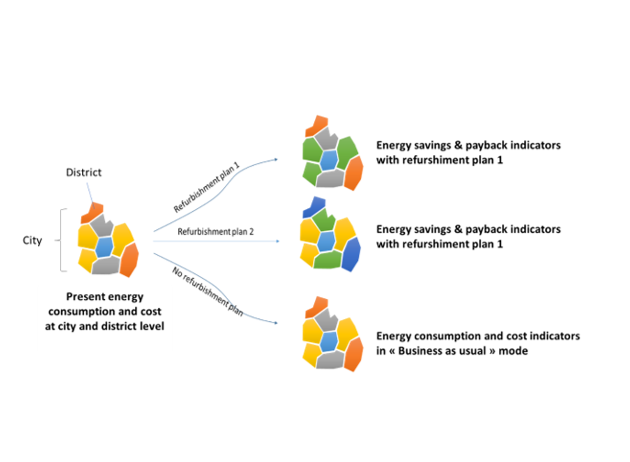CROCUS tool to assess and select a refurbishment plan
CROCUS (deCision suppoRt fOr distriCt refUrbiShment) is a prototype tool that helps simulate the energy use of a city’s building stock and provides a cost/benefit analysis of different refurbishment strategies. The tool aims to help the technical departments of cities in the elaboration of long-term refurbishment plans.
CROCUS was developed by Sinfonia partners DOWEL, CSTB and RISE, combining several software bricks (described below):
- The simulation of buildings’ energy consumptions based on the buildings’ characteristics (performed by the DimoSim Upgrade module);
- The optimisation of the district heating operation (performed by the Friendly Sam tool);
- The economic analysis of different retrofitting strategies (as part of Integration layer).
Two levels of retrofitting strategies are simulated at district scale, and compared with a “business as usual” case: the “light renovation” strategy aligns with the energy consumption targets set by the current regulation on renovation, while “deep renovation” aligns with the targets set by the latest (or upcoming) regulations for new buildings. In both cases, the simulation is focused on improving the building envelope. Different future scenarios (e.g. evolution of energy prices and CO₂ prices) can be simulated.
As its main output, CROCUS provides a cost/benefit analysis comparing the investment costs of different retrofitting strategies, the related energy and CO₂ savings potential, and associated economic indicators.
Tests with pilot cities highlight the criticality of input data availability
CROCUS was tested in the Sinfonia pilot cities (Bolzano, Innsbruck) and in the early adopter cities of Boras, Rosenheim and La Rochelle. The simulations performed helped identify the districts with the most potential for refurbishment.
During this testing phase, the main challenge was to access and collect from city departments the input data required to run the simulations (building footprint, age and height - collected as GIS (Geographic Information System) data sets, data on district heating networks, on building occupancy, local energy mix and prices, and local renovation costs). Due to the wide variety of data collected, significant resources were needed to pre-process them into a common format. The data collection process thus represented a good opportunity for city services to better exchange and centralise the data coming from different departments.
The CROCUS tool is directly related to other tools developed by SINFONIA partners
- DimoSim upgrade: Building thermal load simulation module for large-scale districts (up to city level), based on 3D mockups and/or GIS data developed by CSTB. The simulation engine is written in Python2 and integrates building physical models (RC models), solar mask processor (between buildings) and adjacencies detection (for coupled thermal zones). Simulation time steps and period can be user-defined depending on the desired level of accuracy (typically from 10min up to 1hour).
- Friendly Sam: Friendly Sam, developed by RISE, simulates operation decisions in an energy system by solving the economic dispatch optimization problem. The tool concerns the distribution system for heat and electricity, local electric power generation, district heating, demand for heating/cooling and electricity, and representation of system boundaries. It optimises the operation of the district heating and local power generation based on the input from the other modules in CROCUS. It is published on github under LGPL v3 license free to use by any organization: https://github.com/sp-etx/friendlysam
- Dashboard: A web interface developed by CSTB as part of a decision-making tool allowing to visualize building footprints on a 2D map of an urban district and related data on a selection of buildings (e.g. operational data, results of simulation, KPIs…).
- Integration layer: Integration layer for the modules Friendly Sam and DimoSim based on python algorithms to calculate environmental and economic KPIs and PV potential.
